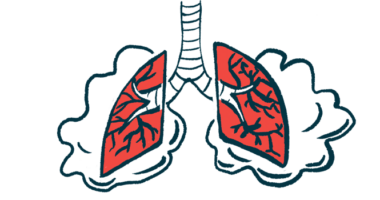Kalydeco Improves Lung Function in Patient Carrying Responsive and Non-responsive Mutations, Case Study Reports

Treatment with Kalydeco (ivacaftor) alone improved lung function and quality of life in a cystic fibrosis patient carrying both a therapy-responsive and a non-responsive mutation to treatment, a case study reports.
The case study, titled “Positive clinical outcomes following ivacaftor treatment in a cystic fibrosis patient with the genotype 3272–26A > G/Q493X,” was published in the Journal of Cystic Fibrosis.
The patient, a 35-year-old woman, was diagnosed with CF as a newborn. She carried two CF-causing mutations: the Q493X, a class 1 mutation that is not responsive to therapy, and 3272–26A > G, a class 5 mutation that does respond to treatment.
More than 1,700 mutations have been identified in the CFTR gene — the gene defective in people with CF — according to the Cystic Fibrosis Foundation. These mutations are generally grouped into different classes based on how they affect the protein encoded by the CFTR gene, and the treatment options available.
Class 1 mutations keep the messenger RNA, or mRNA — a molecule generated from DNA that contains the information to make proteins — from even being produced. Class 5 mutations lead to CFTR protein being produced, but just not in sufficient amounts.
This patient had reasonable lung function, but with significant upper lobe bronchiectasis, which is a permanent enlargement of the airways with build-up of mucus accumulation. She was taking a nebulized mixture to treat her bronchiectasis. To help with sputum release, the patient also performed daily airway clearance, and did aerobic exercise twice a week.
Treatment with Kalydeco was started as a trial for two months, with clinicians monitoring several parameters at the start and at the end of treatment.
Kalydeco, marketed by Vertex Pharmaceuticals, is an approved CF therapy for patients ages 6 months and older who carry any of 38 specific mutations in the CFTR gene, including the 3272–26A > G.
According to the Sino-Nasal Outcome Test (SNOT-22) and Revised Cystic Fibrosis Quality of Life Questionnaire (CFQ-R), the patient experienced improvements on both upper and lower respiratory tract health upon treatment with Kalydeco. The woman also experienced improvements in quality of life, especially on physical state, vitality, and health domains of the CFQ-R score.
Periodic CT scans showed that the patient had a reduction in mucus accumulation in the lungs after two months of treatment. In this period, she also increased her weight by 3.4 kg, without diet changes.
Lung function also improved after the 2-month treatment period, and was sustained for one year following treatment initiation. Further, cardiopulmonary exercise tests demonstrated that the patient improved her workload and maximal oxygen consumption (VO2).
Previous data from the Phase 3 EXPAND trial (NCT02392234) showed that CF patients carrying the F508del mutation — the most common mutation in cystic fibrosis — and the 3272–26A > G mutation responded to Kalydeco treatment alone or combined with Symkevi (Symdeko in the U.S.).
This patient carried the 3272–26A > G mutation as well as the Q493X mutation, which is not responsive to Kalydeco treatment. However, she did not have the F508del mutation, the researchers said.
The data from this case report suggest that the improvements seen with Kalydeco as a single agent on the EXPAND trial could be due to the therapy’s effects on the 3272–26A > G mutation — which is responsive to Kalydeco treatment — since the second mutation does not respond to this medication.
“It is therefore reasonable to expect that ivacaftor [Kalydeco] may provide beneficial results in a … patient with 3272–26A > G on one allele and a mutation not predicted to respond to potentiation [an increase in strength of nerve impulses] on the other, as in this case,” the researchers said.
The team suggested that “similar clinical benefits may also be observed in patients with other residual function mutations … despite not having an F508del mutation on their second allele.”







